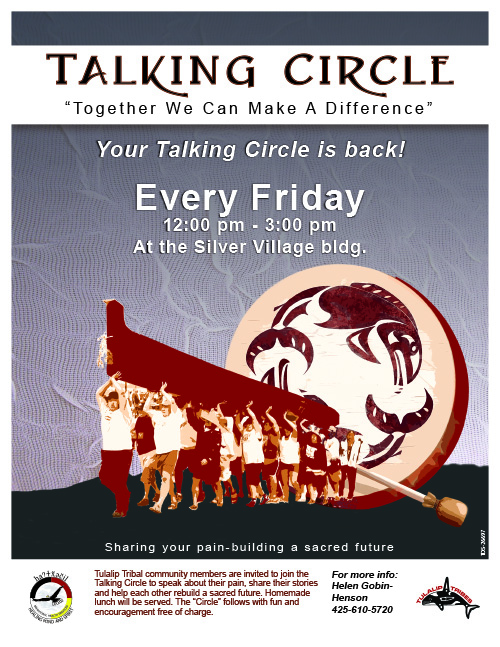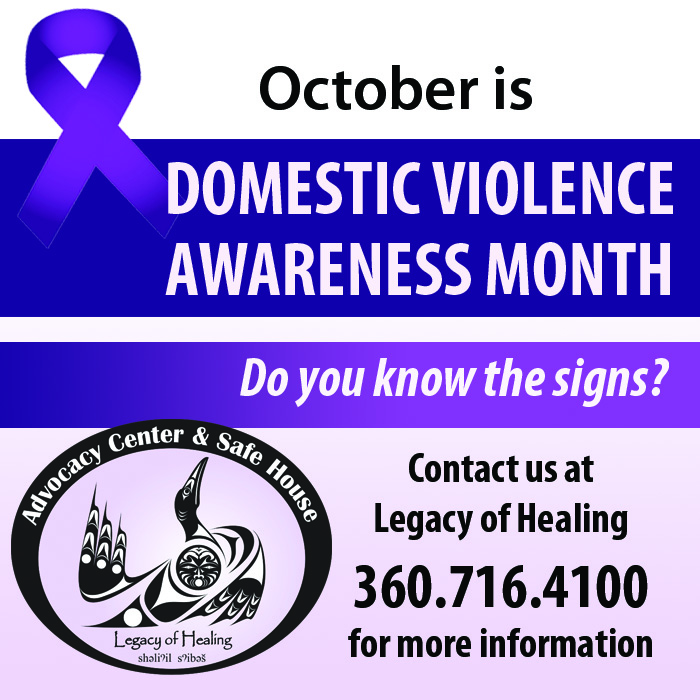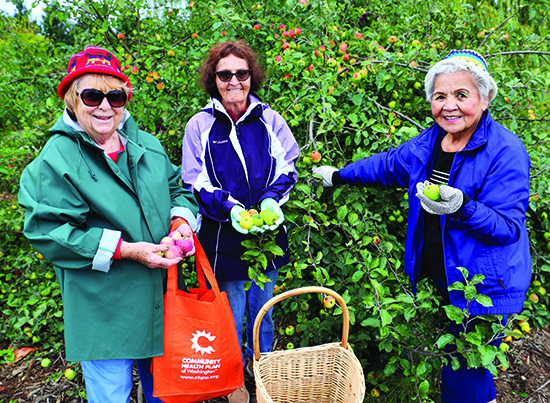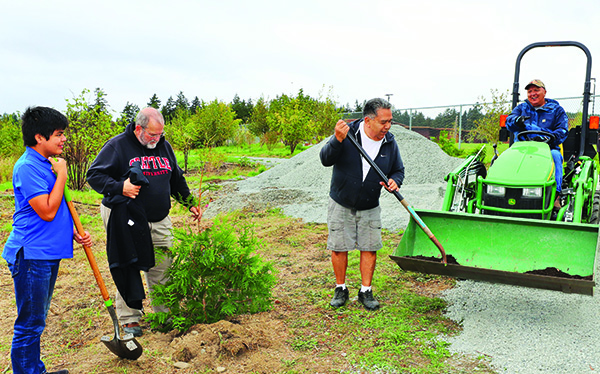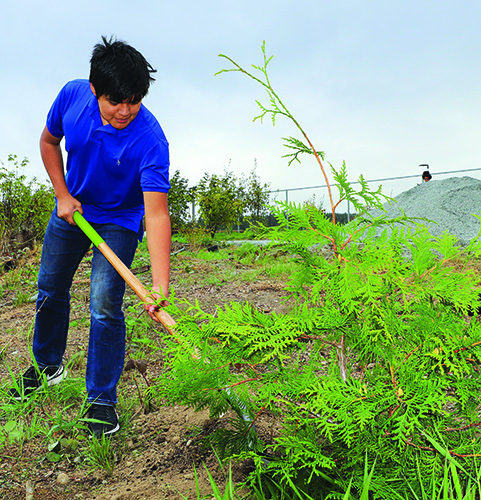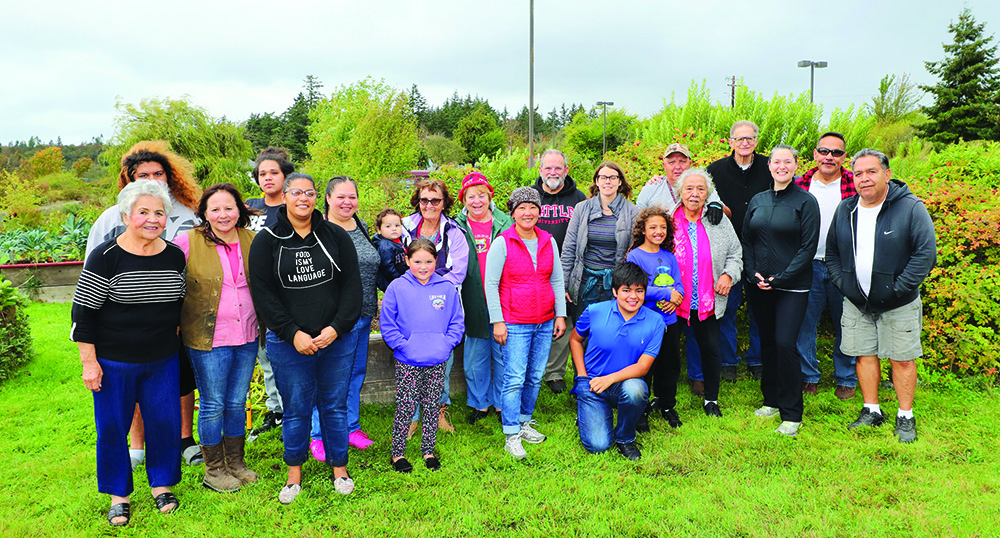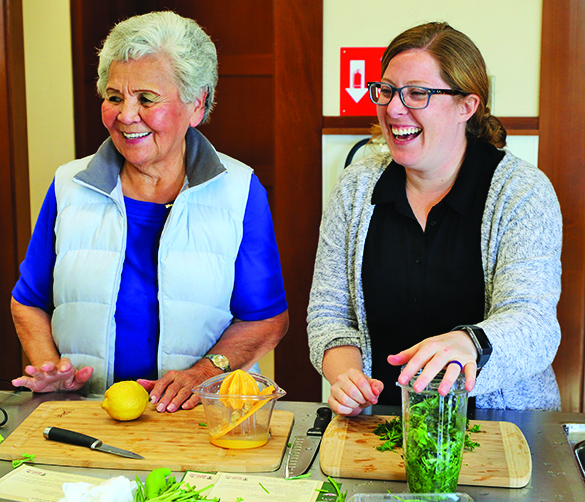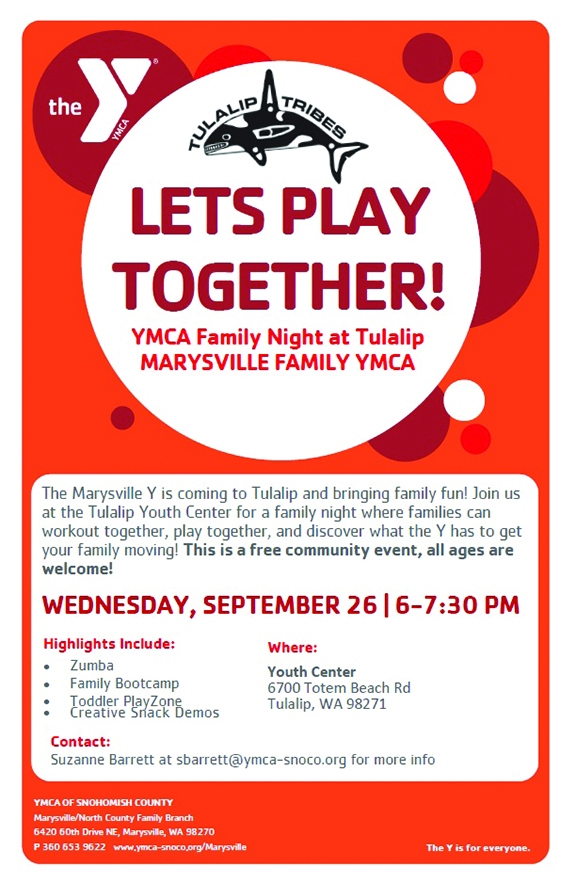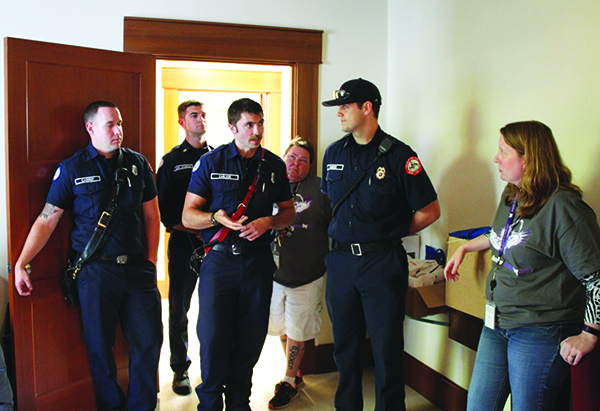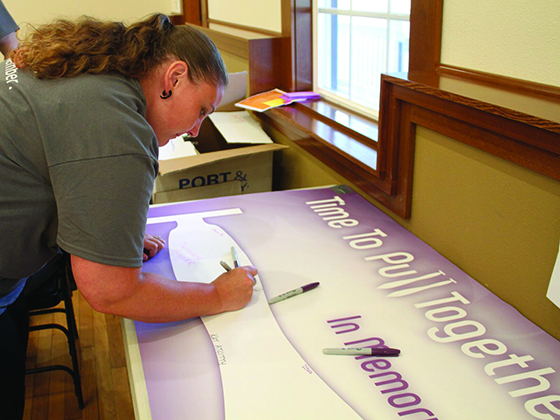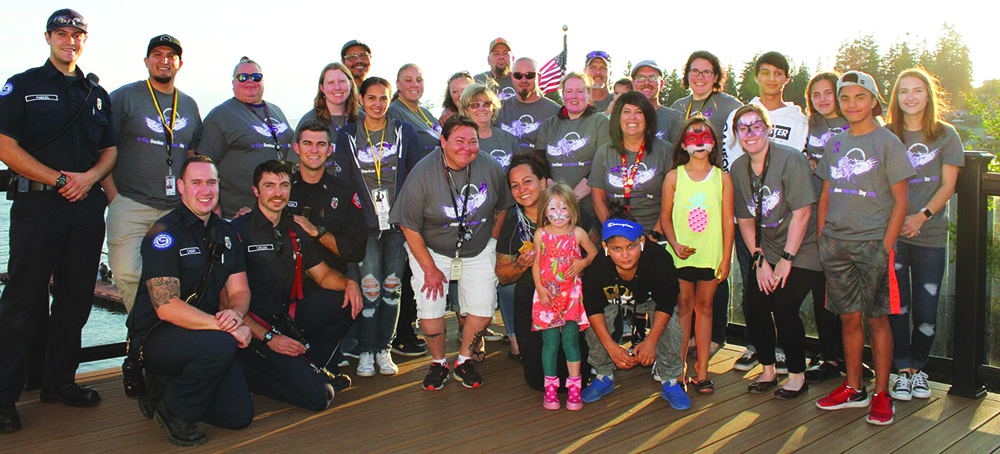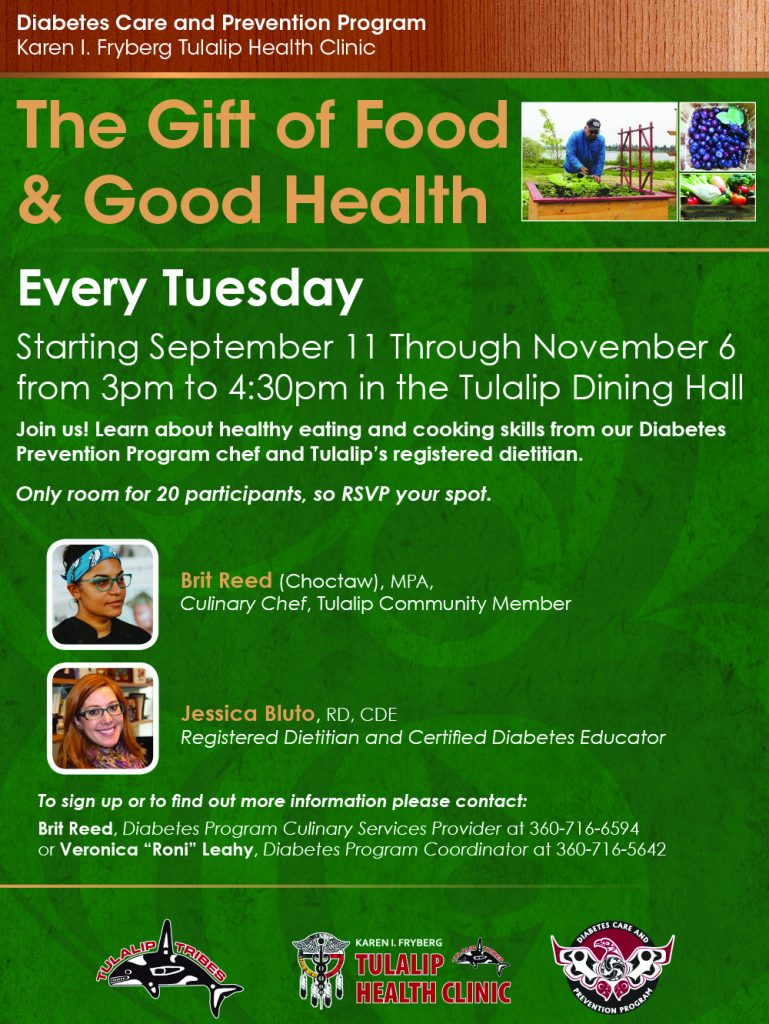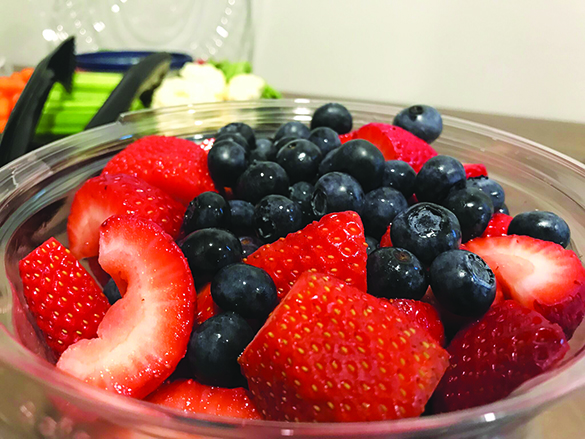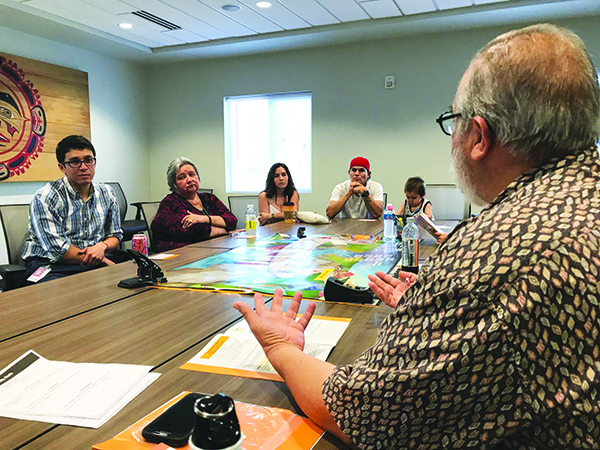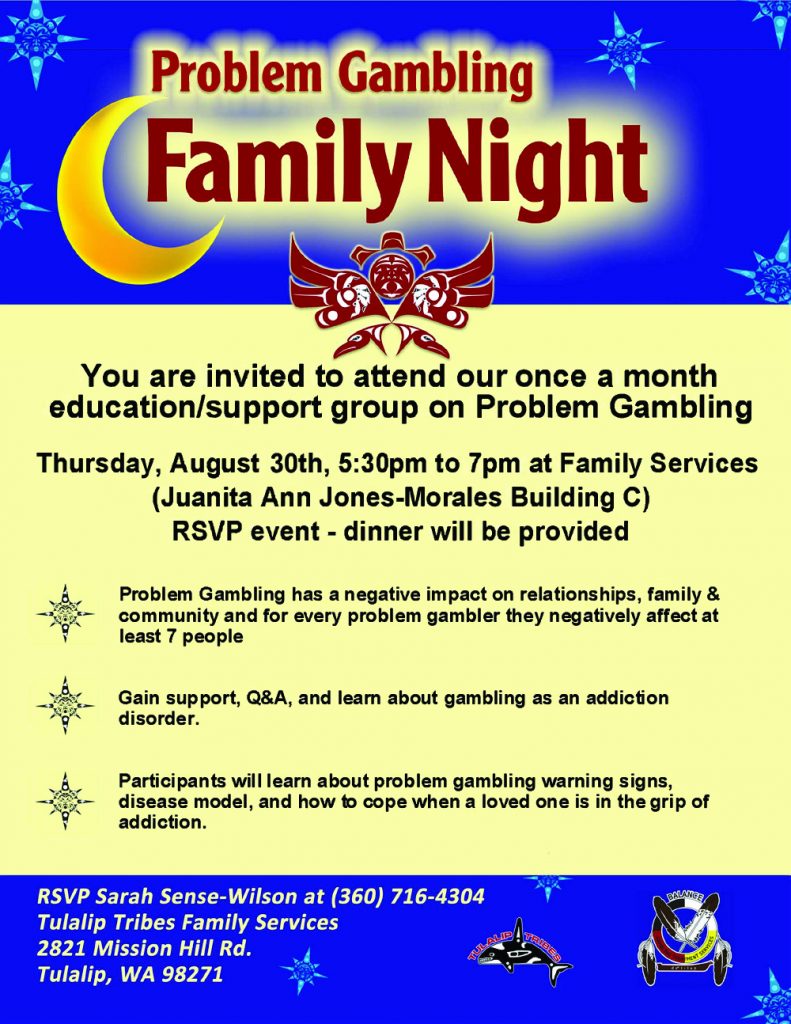Category: Health
October is Domestic Violence Awareness Month
Wellness garden offers sense of community and strength of Cedar

By Micheal Rios, Tulalip News
In the midst of fast-paced urban Tulalip, there exists a lush, quiet oasis. A special place that invigorates the spirit and awakens our long-held connection with nature. Located next to the health clinic, this hidden gem is the Wellness Garden and Trail.
Carefully cultivated and crafted over the last few years, the Wellness Garden and Trail has come to represent community engagement at its finest. Veronica Leahy, Diabetes Program Coordinator for the Tulalip Health System, and her dedicated team of health-conscious staff members have been instrumental in fostering the sense of community a wellness garden can offer.
“Our goal has always been to make everyone feel welcomed, needed and valued,” reflected Veronica on the success of garden day classes routinely hosted at the Wellness Garden. “Our diabetes prevention team is greatly appreciated; everyone gives their all for our events. I feel humbled to be a part of the effort to teach people about healthy foods and increased activity in ways the community connects with. This is the essence of a proactive, holistic approach to diabetes care and prevention.”
A community of expert and novice gardeners made up of tribal members of all ages routinely attends the monthly garden day classes. Over the past planting season, the group tended the soil and grew vegetables (kale, squash, zucchini, cabbage), edible flowers (sunflowers, lavender, nettles), an assortment of seasoning herbs, and berries galore. Raspberries, strawberries, elderberries, and salmonberries, just to name a few, have all taken to the Wellness Garden’s planting beds and have shared their sweet nectar via healthy snacks and meals.
During summer’s final Saturday, the community gardeners came together for this season’s last garden day walk and gathering. There were nearly 30 community members altogether, varying in age and expertise, who enjoyed getting their hands dirty by weeding and pruning the garden, before harvesting apples and pears aplenty. A memorable experienced was shared when the group planted several baby Cedar trees.
“It’s been such a lovely day,” shared honorary tribal member, Father Pat Twohy. “Everybody came together with good spirits to work in the garden. There was so much happiness shared while we picked apples, pulled weeds, and especially when we planted Cedars. To top it off, the cooks provided us with a lovely breakfast and magnificent lunch. Altogether, it was a happy day and I’m so grateful for everyone who made this possible.”
Gardening is a great way to incorporate the power of ancient wisdom and traditions while cultivating food to bring about growth and healing. There is tranquility in the sounds of nature, the smell of fresh earth, and the warmth from the sun. Most gardeners agree that they feel a sense of calm wash over them as they work with the plants and flowers. Some even are reminded of a time not too long ago, before cell phones and the internet ruled the day.
“It warms the heart to see so many happy people in one place,” beamed Tulalip elder Virginia Carpenter. “I just love gardening, and it’s so great to see the younger generation come out and be a part of this. Seeing families, parents with their kids, out here having a good time it reminds me of the olden days; when kids used to go with their parents everywhere and people were happy to be out of the house.”
Of the 30 community member who attended the September 22 garden day, several were first-time tribal member participants. They jumped right in to the garden activities and assisted their elders whenever possible.
The youngest and longest attending tribal member, 15-year-old Kaiser Moses who has been attending gardening classes since he was just 4-years-old, was seen teaching others how to plant a variety of crops and how to best harvest the ready fruits. Kaiser reiterated our connection with nature by sharing, “the plants and trees are alive, and it’s up to us to take care of them and keep them healthy.”
“I stood back and listened to Kaiser’s words and teaching and my heart was so full, it was hard to hold the tears back,” added Veronica. “I watched our elders work with the new tribal members and saw real joy in their faces; this is my motivation for the garden days. Every bit of effort and time is worth it to see and feel the community effort shared by all. It has always been and continues to be a very special time for whoever comes and joins us.”
Following several mindful hours in the Wellness Garden, the group organized indoors for a delicious meal cooked by culinary chef, Britt Reed. There were pumpkins and pumpkin carving kits given to everyone, along with a variety of raffle prizes that included gardening supplies and cooking utensils.
This upcoming winter, an all-new greenhouse project will be opening to the community which will allow the gardening activities to continue inside and more classes to be taught around food preservation. Be on the lookout for future flyers detailing this project on Tulalip News and Tulalip News Facebook page.
The Moms Group Meets Every Tuesday
The gift of food and good health
By Micheal Rios, Tulalip News
Tulalip’s own Diabetes Prevention Program is dedicated to making the community healthier by educating any and all motivated individuals who are willing to learn about nutritional awareness and healthy eating. With diabetes and obesity prevalence continuing to rise in Native communities throughout the United States, many families feel a need to change their eating habits, but just don’t know where to begin.
Adjusting to a healthier lifestyle and diet can be an overwhelming task, therefore, the Diabetes Prevention Program has created The Gift of Food & Good Health, an all-new series of cooking classes offering guidance and hands-on instruction. Hosted every Tuesday at the Tulalip Dining Hall from 3:00pm to 4:30pm, these classes are uniquely created for our people to enjoy while learning about the many health benefits of our foods. The classes are open to tribal members, their families, and patients of the Tulalip Health System.
The latest class, occurring on Tuesday, September 18, communicated the importance spices and herbs can have in creating healthy meals.
“Herbs and spices make food tastier while boosting your health,” shared Jessica Bluto, a registered dietitian and certified diabetes educator for the Tulalip Health Clinic. “We should all be cooking with herbs and spices regularly and, if possible, using several at a time.”
Herbs, like basil, are the leaves of a plant, while spices, like cinnamon, are usually made from the seeds, berries, bark, or roots of a plant. Both are used to flavor food, but research shows they’re chock-full of healthy compounds and may help prevent illness and disease.
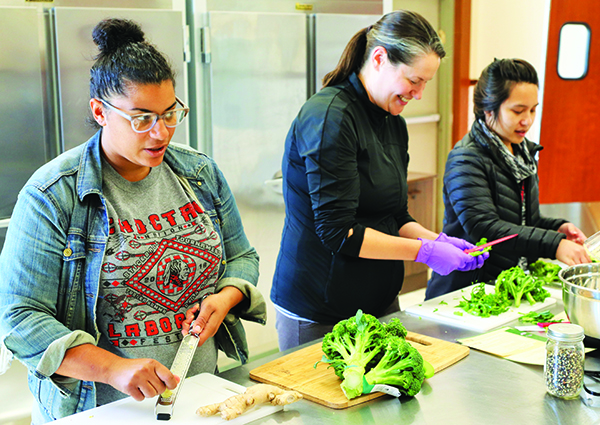
Adding herbs and spices to your diet has another benefit, “Because they’re so flavorful, they make it easier to cut back on less healthy ingredients like salt, sugar, and added fat,” explained culinary chef Brit Reed. “Herbs and spices contain so much nutritional value, from cleaning out toxins in your blood to fighting inflammation to even lowering blood pressure. We’re all about promoting healthy foods habits that can really make a difference with a variety of health issues our people may be going through.”
Tulalip elder Marvin Jones attended the September 18 session as a first-timer. He enjoyed learning about the variety of health benefits herbs and spices can offer, even though he admitted to not enjoying the flavor of most of them.
“I don’t like the taste of most seasonings, but I’ll try to eat them and come up with a combination that works for me because I want to eat better,” said Marvin while going through the process of mincing garlic. “I want to learn to cook healthier foods and meals. These classes will help me with that.”
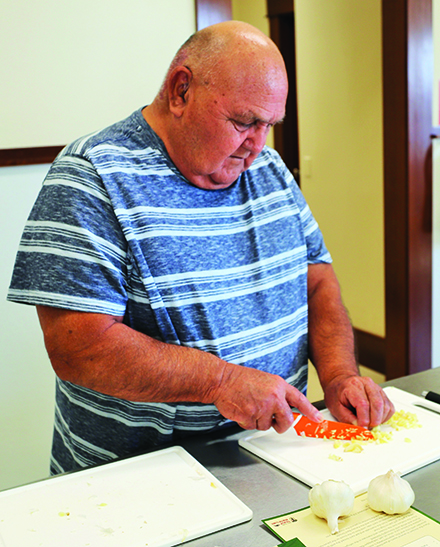
The exciting hands-on learning experience walked each class attendee through the food preparation process, to the large Dining Hall kitchen for cooking as group, and then back to the table where a grilled chicken and broccoli meal was enjoyed by all. The meal was made flavorful with the aid of garlic (anti-inflammatory), basil (digestive aid), ginger (nausea reducer), and thyme (antimicrobial), along with a variety of fruits and vegetables.
“The staff here have been so helpful in teaching me which foods to eat more of and how to make sense of a nutritional label,” shared Joyce Alexander, a Haida elder. Joyce routinely attends healthy cooking and food classes offered by the Diabetes Prevention Program. “I was diagnosed with border line Diabetes two years ago and was told by the doctors it could be reversed by changing the foods I eat. Since then, I’ve lost nearly 52 pounds just by changing my diet and staying away from processed foods. I’ve taken back control of my life and it feels great.”
The Gift of Food & Good Health series will continue next Tuesday with a class dedicated to tender, juicy steak. As always the Diabetes Prevention Program welcomes any community members interested in learning about the many health benefits of food.
“There is so much information available about healthy eating and cooking skills, and we want to aid, however we can, in our people being comfortable applying these skills in their daily lives,” said Chef Brit. “This series of classes will cover a whole range of health benefits. And don’t worry if you can’t make them all. If you can make time to attend just one or two, we’d love to share a nutritious meal with you.”
To find out more information about The Gift of Food & Good Health series please contact Brit Reed, Diabetes Program Culinary Services Provider at 360-716-6594 or Veronica Leahy, Diabetes Program Coordinator at 360-716-5642.
Marysville YMCA Family Night at Tulalip, Sept 26
Tulalip community members trained in overdose awareness
By Kalvin Valdillez, Tulalip News
A trail of signs was posted along Totem Beach Road leading to the Tulalip Dining Hall on Friday, August 31. Each sign displayed a single person silhouetted in purple, with the main Dining Hall sign saying, “Each nameless, faceless person represents a life lost to overdose.” Inside, the community gathered on International Overdose Awareness Day to remember lost loved ones, share personal stories and learn more about the opioid epidemic that has claimed more lives than the Vietnam War, in 2017 alone.
In their second year hosting the annual International Overdose Awareness event, the Tulalip Community Health department united the people of Tulalip while shining light on a serious topic. The theme for this year’s event was Time to Pull Together and participants were invited to write personal messages to any friends or family members who lost their life due to an overdose, on large posters displaying traditional cedar paddles.
“There was over 72,000 drug overdoses in the United States last year,” said Tulalip Interim Police Chief Sherman Pruitt to the group of attendees. “That’s almost two hundred people dying every day from overdose. In Snohomish county, the percentage of drug related deaths was approximately thirty-two percent in 2017; in the state of Washington, the number of drug related deaths was approximately thirty-three percent. The Tulalip tribal reservation drug related deaths is at two hundred and twenty-three percent.”
Gasps were heard from around the Dining Hall as the Chief shared this statistic. Event participants were shocked and shared a look of disbelief.
“It’s a serious problem,” he continued. “Our officers carry two Narcan kits on them and we are constantly using them. The Board of Directors wanted us to implement a Drug Task Force, so I started that in March. I’ve assigned officers to the task force so we can start addressing some of these issues with the individuals who are supplying drugs to our family members and community, and make sure we hold them accountable as well as provide services to get them the help that they need.”
Chief Pruitt also explained the Good Samaritan Law to the participants. The Tribe adopted the law back in 2014 after Lois Luella Jones died from an overdose. Authorities believe her life could have been saved, but in fear of arrest, her peers failed to contact emergency responders.
“It’s okay to call,” he reassured. “Because of the Good Samaritan Law, you’re not going to get in trouble. Our priority as law enforcement officers is the preservation of life, so give us a call so we can provide assistance.”
Community members shared stories of addiction, heartbreak and loss from substance abuse. The Health Department also held a Narcan training for the community so they know how to quickly revive someone who has overdosed. The training was led by Gina Skinner and Jane Jacobson who explained in detail how the Narcan nasal spray works.
“In an overdose situation, the opiate has hit receptors in the body that cause respiratory depression and your pupils to get small. The Narcan comes in and kicks the opiate out of the receptors and takes its space,” explains Jane. “That makes the patient go into a withdrawal and it allows their respiratory rate to improve, making it easier to breathe and they start to come out of that overdose situation. But they have to get treatment within about thirty to ninety minutes otherwise the opiate could come back and kick the Narcan out of the receptor and cause an overdose situation again.”
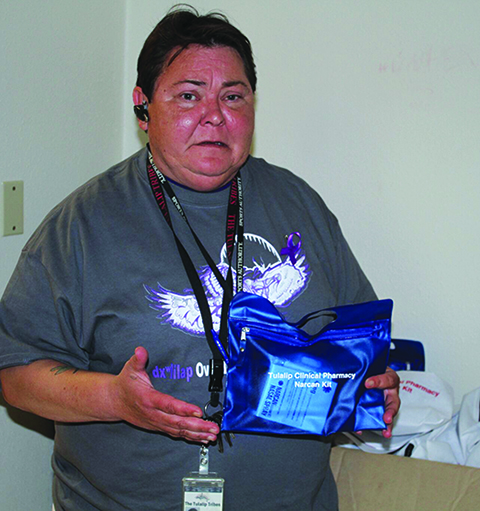 The Tulalip Bay Fire Department joined the trainers to give insight on their procedure during overdose emergencies and how they utilize Narcan. Each participant who attended the training received a free Narcan kit. Tulalip community members are encouraged to pick up a kit of their own, free to Tulalip tribal members at Tulalip Family Services and available to community members through their insurance at the Karen I. Fryberg Health Clinic pharmacy.
The Tulalip Bay Fire Department joined the trainers to give insight on their procedure during overdose emergencies and how they utilize Narcan. Each participant who attended the training received a free Narcan kit. Tulalip community members are encouraged to pick up a kit of their own, free to Tulalip tribal members at Tulalip Family Services and available to community members through their insurance at the Karen I. Fryberg Health Clinic pharmacy.
“This was our second annual International Overdose Awareness Day event,” states Tulalip Community Health Director, Jenna Bowman. “It’s important that we let people know we’re here and we’re creating awareness about things they can do to help prevent overdose and also a space just to be around other family members who may be suffering. As a community, we’re all connected, we’re all suffering. There’s always been a stigma behind talking about overdose and addiction and I think it’s important we move passed that and support each other, whether we’re going through it and lost someone or maybe we’re struggling to find the answers ourselves. It’s important that we support each other.”
For more information, please contact the Tulalip Community Health Department at (360) 716-5622.
The Gift of Food and Good Health, Sept 11-Nov 6
Finding your way with diabetes
By Kalvin Valdillez, Tulalip News
The Tulalip Diabetes Care and Prevention program hosted a series of classes for the community during the month of August. Led by Diabetes Educators Jessica Bluto and Miguel Artega, Finding Your Way with Diabetes is an interactive course where community members learn how to manage their diabetes by sharing their personal experience with other diabetics in the community.
Diabetes is prevalent in many Native communities throughout the country. In fact, Indigenous people are at a much greater risk of being diagnosed with diabetes than any other race in America. However, recent research by the Centers for Disease Control and Prevention (CDC) revealed that Native America is actively working to change those statistics and saw a huge drop in the amount of kidney failures caused by diabetes in 2017, down by about fifty-four percent than previous years. Thanks to programs like Diabetes Care and Prevention, Natives have a better understanding of diabetes and how to properly care for the disease by making healthier choices.
Eight community members participated in the class last month and talked about a number of topics such as nutrition, the different types of insulin and their daily triumphs and struggles while living with diabetes. Miguel and Jessica compiled a list of topics for the participants to discuss before each class. The students then used a conversation map, which resembled a large board game, to lead their conversation throughout the class.
“Over the past four classes we’ve been doing the diabetes conversation map,” says Jessica. “The first class talked about the basics of dealing with diabetes, from medication to balancing your diet, to coping with your feelings. We also talk about what causes your blood sugar to fluctuate and frustrations that people feel with diabetes. I think it’s important for them to share because they learn from each other and also know that they’re not alone. Even though a lot of people have diabetes, not a lot of people are willing to talk about their experience which keeps them from moving forward and better managing it. When they come to this class, they open up to each other and they’re building a community together.”
An example of community building was on display during the last class of the month as they welcomed a young new comer, who was diagnosed with diabetes a few short years ago. The class embraced the young man as he opened up about his journey with diabetes and encouraged him to keep pushing forward, offering friendly advice and letting him know what lies ahead.
Tulalip community member and Alaskan Native, Jim Dunham has lived with diabetes for over twenty years and happily passed on his knowledge and experience to his classmates.
“It’s not easy to change your lifestyle,” Jim states. “When you find out you have a sickness like diabetes you need to change your lifestyle and adapt. A lot of times when you go to your doctor, they give you a lot of information and sometimes you can’t fully grasp everything they’re telling you. I’ve learned so much more by coming to these classes over the last five years and have been able to manage my diabetes better. I’ve been dealing with this for over twenty years and am so thankful for these classes and this program, it really is phenomenal for our community.”
If you are living with diabetes or have recently been diagnosed with the disease, Jessica and Miguel encourage you to drop by the Diabetes Care and Prevention program at the Karen I. Health Clinic so they can answer any questions, provide you with resources and get you setup with a personalized plan to help manage your blood glucose levels.
“Diabetes can be different for everybody,” explains Jessica. “If you feel the plan you and your doctor made isn’t right for you, let your doctor know because there are wide variety of ways to manage diabetes as well as medication. Come on down and visit, chat with us. We always have prizes at the classes and we always try to feed you. The purpose is to show you different kinds of healthy foods so you have the opportunity to try it before you buy it.
We have another series coming up this fall or winter, the American Association for Diabetes Educators: The Seven Pillars of Managing Diabetes. Be sure to follow our Tulalip Food & Nutrition Education Facebook page for more information and upcoming events.”
